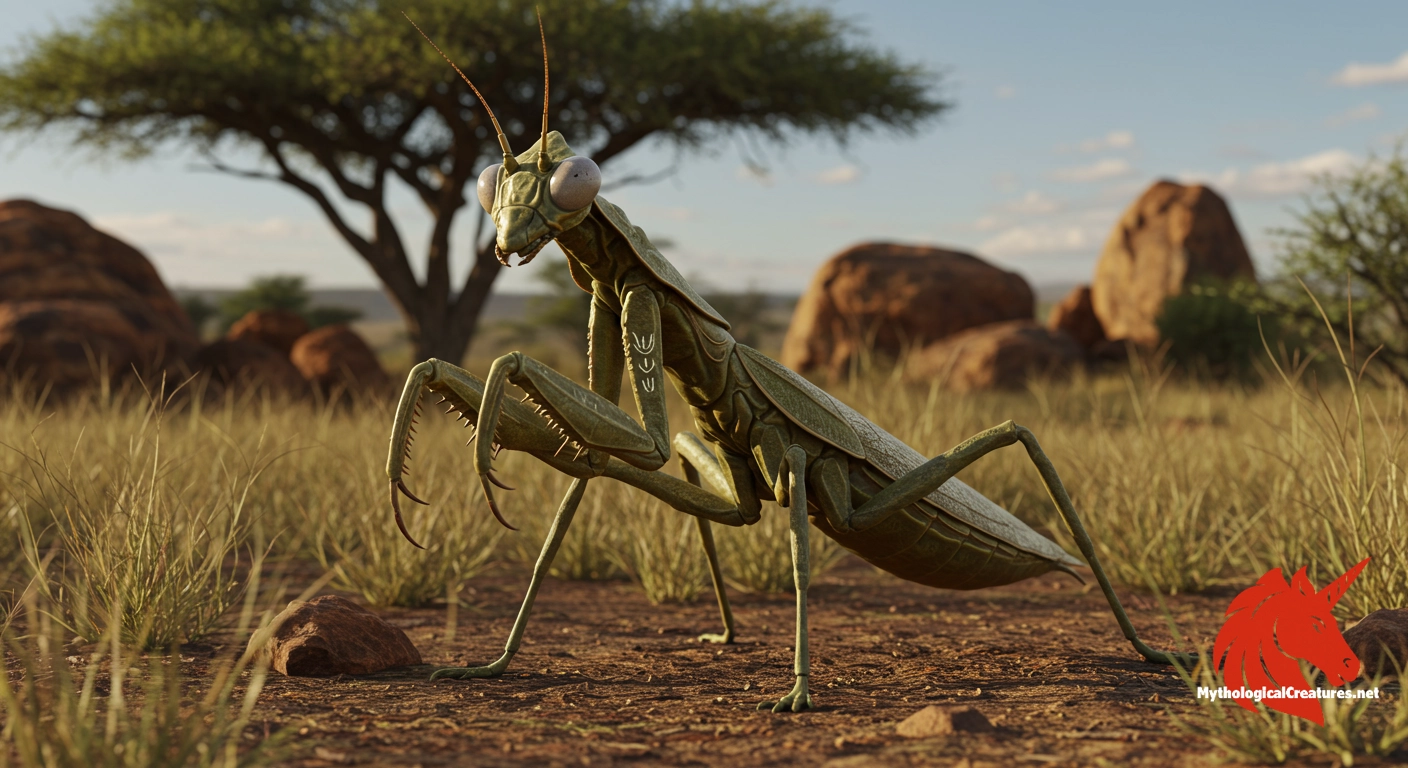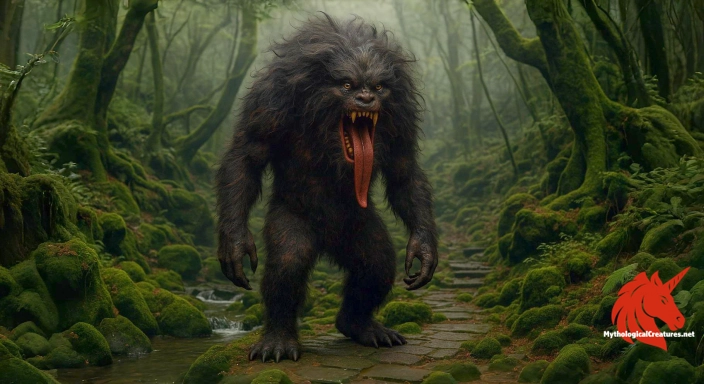ǀKaggen: ŊKaggen, often known as Mantis, is a demiurge and folk hero from San mythology.

ǀKaggen
ǀKaggen - A central figure in San folklore, Kaggen is revered for his creative power and trickster nature that influence both the natural and spiritual worlds.
Origins & First Encounters
ǀKaggen stands as an enigmatic and multifaceted figure within the rich oral traditions of the San people, revered both as a creative demiurge and a playful trickster. His origins are rooted deep in the lifeways of southern Africa, where ancient storytelling has preserved his dual nature across countless generations. He is celebrated not only for his cunning exploits but also for his capacity to forge and renew life, embodying the eternal cycles of nature. Oral accounts, passed down through ritual, song, and dance, reveal a deity who transcends simple categorisation, merging creation with mischief. His earliest attestations suggest that he was more than a mythic being—he was a vital force interwoven with the spiritual and physical worlds. The layered narratives about him have long served to instruct and entertain, reflecting the community’s respect for both the natural environment and the mysteries beyond. His stories often illustrate the balance between order and chaos, encouraging followers to embrace adaptability and change. Over time, his identity has evolved to incorporate elements of both cosmic wisdom and trickery, making him an enduring symbol in San culture. The transformative aspect of his myth continues to captivate and inspire, highlighting the dynamic interplay between human ingenuity and the natural world.
Source Texts & Tale Variants
ǀKaggen’s enduring legend is largely preserved through a vibrant tradition of oral storytelling amongst the San people, where his multifarious exploits are recounted with passion and reverence. His narrative is woven into songs, ritual performances, and visual art that have been passed down through countless generations. Ethnographic studies have captured various renditions of his tale, each reflecting subtle differences that arise from the oral transmission process. These diverse versions offer insights into his roles as both creator and trickster, emphasising different aspects depending on the storyteller and local context. Some accounts focus on his benevolent acts that underscore the origins of nature and life, while others highlight his mischievous interventions that challenge established norms. The absence of a singular written account has allowed the myth to evolve organically, adapting to the changing cultural landscapes of the San. Various field recordings and anthropological notes further enrich our understanding of his legend, capturing the spontaneity and creativity inherent in oral traditions. Ritualistic chants and artistic depictions amplify his presence, affirming his status as a living and dynamic figure in the cultural memory of the community. The multiplicity of sources not only underlines his complexity but also highlights the importance of oral heritage in maintaining the mythological fabric of southern Africa. Through these varied narratives, ǀKaggen continues to resonate as a symbol of innovation and the mysterious forces of the natural world.
Form & Powers
ǀKaggen is most commonly visualised in the form of a praying mantis, a shape that epitomises both elegance and an otherworldly wisdom. In this form, his lithe, segmented body and angular limbs suggest agility and precision, imbuing him with an air of mysticism. Yet his transformative abilities do not end there; he has also been portrayed as a formidable bull eland, a diminutive louse, a slithering snake, and even a crawling caterpillar. Each incarnation offers a distinct representation of his character, symbolising the wide spectrum of life and the inherent unpredictability of nature. As a bull eland, his physical presence is magnified, underscoring strength and the rugged majesty of African wildlife. His smaller forms, like that of a louse or caterpillar, reflect his intimate connection with the minutiae of the natural world, suggesting that even the tiniest creatures hold monumental significance. In his snake form, the imagery evokes ideas of regeneration and hidden knowledge, common themes found throughout mythological traditions. Across all these embodiments, there remains a consistent glimmer of playful cunning and profound insight, marking the seamless blend of beauty and trickery. This fluidity in appearance is not merely a physical trait but serves as a symbolic reminder of the transformative forces that govern both the natural and spiritual realms.
Regional Faces
The portrayal of ǀKaggen varies noticeably across the diverse regions inhabited by the San people, reflecting local environmental contexts and cultural nuances. In some communities, his creative role is accentuated, with narratives focusing on his contributions to the generation of life and the maintenance of nature's balance. Elsewhere, the mischievous and unpredictable aspects of his character are given prominence, serving as cautionary tales and sources of humour in everyday life. Variations in his name, often rendered as Cagn or Mantis in different locales, further illustrate the fluidity and adaptability of his myth. Regional retellings sometimes incorporate local fauna and landscape features, linking his shape-shifting abilities directly to the surrounding ecosystem. This adaptability underscores how his persona can be locally tailored to address specific societal and environmental concerns. Local rituals and ceremonies have, over time, integrated unique interpretations of his legend into their performance, reinforcing community identity. The regional adaptations ensure that ǀKaggen remains a living, breathing element of San cultural heritage, responsive to the changing contexts of daily life. These localized versions serve as compelling examples of how myth can bridge the gap between geography and spirituality, resonating deeply with those who tell the tale.
Cultural Parallels
ǀKaggen occupies a distinctive place in world mythology, drawing fascinating parallels with other trickster deities and shape-shifting figures from diverse cultures. Like the Norse deity Loki, he embodies the paradoxical roles of both creator and disruptor, skilfully navigating the realms of order and chaos. His capacity for transformation is reminiscent of other shape-shifters in myth, who use their mutable forms to reveal hidden truths about existence. In West African cultures, figures such as Anansi similarly employ wit and cunning to subvert expectations and challenge societal norms. These cross-cultural comparisons highlight a universal motif found in many mythologies: the celebration of the unexpected and the transformative power of mischief. The archetype represented by ǀKaggen serves as a reminder that all beings, no matter how small or seemingly insignificant, are capable of profound change. His multifaceted character also invites comparisons with deities in other traditions that blend humour with wisdom, illustrating a shared human fascination with duality and complexity. The study of such parallels enriches our understanding of how different cultures utilise myth to explore universal themes like creativity, resilience, and the delicate balance between chaos and harmony. Through these comparative lenses, ǀKaggen emerges not only as a local icon but also as part of a broader tapestry of myth-making that spans continents and epochs.
Legacy & Modern Evolution
Over the centuries, ǀKaggen has evolved from a predominantly oral myth into a symbol with significant modern resonance, celebrated in various artistic and cultural discourses. His timeless narratives continue to inspire contemporary literature, visual art, and theatre, where his shape-shifting and trickster traits are reinterpreted to address modern dilemmas. This enduring appeal has rendered him an emblem of creativity and subversion, challenging the constraints of conventional thinking in both spiritual and secular contexts. While his origins are deeply embedded in the traditions of the San, current cultural movements have embraced his legend as a metaphor for transformation and the unpredictable nature of life. Modern reinterpretations often highlight his role as a mediator between humanity and the natural world, adding layers of environmental and existential significance to his myth. His image can be found on modern canvases, in films, and even in musical compositions that seek to draw on indigenous wisdom. The dynamic evolution of his story underscores the lasting influence of oral traditions and the power of myth to adapt over time. As a subject of both academic study and popular fascination, ǀKaggen continues to bridge ancient wisdom and contemporary thought. His legacy is a vibrant testimony to the resilience of cultural narratives and the universal human quest to understand the mysteries of existence. In embracing both his historical roots and modern expressions, ǀKaggen remains a powerful figure within the global mythological landscape.
Interesting Fact
An interesting aspect of Kaggen is his ability to transform from the minuscule louse to the mighty bull eland, symbolising the vast spectrum of life and the inherent unity of nature.
Quick Creature Info
Origin:
Features:
Associations:
Our Mythic Legendary Rating:

Also Sometimes Known As:
Habitat:
Supernatural Powers:
Physical Attributes:
Abilities:
Behavior:
Lore:
Related Creatures, Tales or Lore
- AAnansi
- EEshu
- CCoyote
References
Discover Another Mythical Legend You May Not Have Heard Of?
Uncover the mysteries of ancient folklore and expand your knowledge of legendary beings from cultures around the world.
Dare to Meet the Akashita....
Curated by the Mythological Creatures Team (rev. May 2025)
